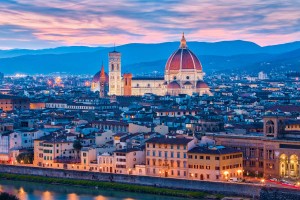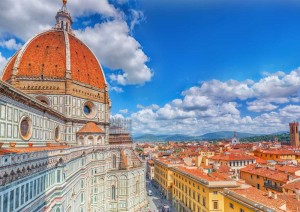
©Bigstock.com/Nattee Chalermitargool
Florence, city of art and culture. The former Etruscan settlement was Italy’s richest city during the Renaissance and became home to some of the country’s greatest painters and architects. They all left their unique mark on the historic centre, the Centro Storico. Rich in luxurious buildings and stunning pieces of art, the historic centre of Florence certainly deserves to be called UNESCO World Heritage Site. But how did it come to this architectural and artistic boom in Tuscany? And which of the numerous palazzi and buildings are absolute must-visits for your next trips?
Florence’s history
Contrary to many other cities, Florence’s history survived in great detail, thanks to Niccolò Machiavelli. He started to write everything down around 1520 and became one of the first historians ever. Thus, we know, for instance, that the first settlements in this area date back to Etruscan times, before the Romans eventually founded the settlement Florentia on a small hill, likely while constructing the Via Flaminia. Florence was under the influence of many other peoples over the course of the following centuries, such as the Ostrogoths and the Lombards.
The foundation of the Republic of Florence in the 12th century triggered the rise of the city with its heyday beginning 200 years later when numerous artists and scholars took up residence here. The reign of the Medici accelerated Florence’s rise to a trade and financial centre before the city gave birth to the Renaissance. Artists such as Donatello, Botticelli, Machiavelli, Michelangelo, Galileo Galilei and Leonardo da Vinci, under the watchful eye of their benefactors, were responsible for this cultural and architectural boom. They all left their distinctive mark on the then-republic and laid the foundation for one of the most important European art periods that was soon to conquer the entire continent.
The historic centre
Surrounded by the ruins of the old 14th century city walls, the historic centre of Florence, named UNESCO World Heritage Site, today comprises a total area of approx. 505 ha. The decision to include it in this illustrious list was made as early as 1982, being only the fourth Italian site to receive such honour, for the reason that it is home to the largest accumulation of universally known pieces of art. The actual territory of the historic city centre includes countless buildings and palazzi you can tour during a city walk of at least two days. If you only have little time available, here are four highlights to focus on.
Santa Maria del Fiore

©Bigstock.com/Brian K.
For years, the Florentine had several smaller churches for all religious purposes and were perfectly satisfied. All of that changed in 1296 when Arnolfo di Cambio’s plans for a cathedral were put into effect. Construction of this monumental building would take 140 years and was eventually assumed by Filippo Brunelleschi, who certainly delivered his masterpiece with the world-famous cupola, its construction alone taking 16 years. Giotto also left his mark with the imposing Campanile. The Gothic look of the monumental building was only completed in later centuries, the front redesigned several times and eventually finished in 1887 using three-coloured marble. Some of the cathedral’s works of art have since been transferred to museums, such as Donatello’s marble statue of John the Baptist. Tremendous frescos and the monumentally yet quaintly painted cupola intrigue to this very day.
Santa Croce
According to legend, Francis of Assisi himself founded this Franciscan church, which was also built by di Cambio. Santa Croce is also known as the “Pantheon of Florence” – not for architectural reasons, but rather because tombs and memorials of some of the most important Renaissance protagonists rest inside it. Michelangelo, Gioachino Rossini, Machiavelli and Galileo Galilei found their last resting place here. Constructions of the church dragged on for centuries, commenced and stopped several times. For instance, the planned addition of a tower was cancelled approx. 300 years after the first stone laying with the remains having since been torn down. However, Santa Croce is everything but incomplete. Find fascinating frescoes and paintings by Giotto and both Gaddis – father and son – inside the church. Sadly, Cimabue’s Crucifixion was badly damaged after severe flooding in 1966, the face of the Redeemer most likely being permanently blurred. Let’s hope there won’t be an old lady trying to re-paint it…
Uffizi
Only built in the second half of the 16th century, the Uffizi are among the younger parts of the UNESCO World Heritage Site. This, however, doesn’t derogate its outstanding position in the slightest, as the complex of buildings, which originally housed administrative offices and ministries, is now home to one of the most important art collections in the entire world. The Galleria degli Uffizi moved in as early as 1580 and has ever since been housing a publicly available collection of sculpting and painting ranging from antiquity to the late baroque period. You will certainly be captivated by some of the world’s most famous pieces of art, such as Botticelli’s “The Birth of Venus”, Raphael’s self-portrait or Leonardo da Vinci’s “The Annunciation”. Likely the most famous piece, however, is the Medici Venus, made in the 1st century BC and inspired by Greek sculptors. Its exact origin remains a mystery to this day.
Palazzo Pitti
This final highlight of Florence’s historic centre is unusual and, at the same time, everything but. As the name suggests, Palazzo Pitti was originally built for the merchant Luca Pitti. It is believed that Brunelleschi himself is responsible for the base of the palace. Contrary to similar fortress-like buildings, the palazzo passed on luxurious decoration and was instead built completely out of ashlars, also known as rustication. Cosimo I de’ Medici had an above-ground walkway built above the Ponte Vecchio connecting the Palazzo Pitti with the Palazzo Vecchio, thereby turning it into an essential part of Florence’s historic centre. Nowadays, the palace mainly acts of home to numerous museums and galleries, such as the Medici art collection and the Royal Apartments. The Boboli Gardens behind the palace features an almost legendary collection of sculptures and the gorgeous Mannerism grotto.
Florence’s historic centre has so many other highlights to offer, such as the Palazzo Vecchio with a replica of Michelangelo’s David on its forecourt or the grand Ponte Vecchio connecting the Uffizi with the Medici palaces. We could write entire books about this collection of architectural and artistic masterpiece, they would never be even remotely complete. We wish you lots of fun with your journey to Tuscany’s Renaissance pearl!